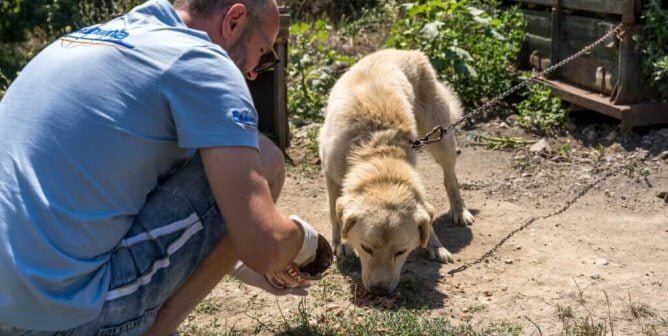Small Animals Were the First Victims of Dahmer, Bundy, and Other Killers
There’s a reason the FBI keeps track of cases of cruelty to animals: It’s often a precursor to escalated levels of violence, most famously illustrated by serial killers and mass shooters such as Jeffrey Dahmer, Ted Bundy, and Nikolas Cruz, who abused other animals before attacking humans.
Studies have shown that animal abuse is a better predictor of sexual assault than previous convictions for homicide, arson, or weapons offenses: Psychology Today reported that 70% of criminals who were most violent to humans in one prison also had a history of animal abuse, and other studies have found that 43% of school shooters have a history of abusing animals. Animal abuse is also one of the most significant factors in someone’s becoming a domestic abuser.
Although a history of cruelty to animals aids authorities in assessing the threat potential of suspected and known criminals, every animal who has suffered at the hands of an abuser is someone deserving of compassion. We must take cruelty to animals seriously, not only to prevent future violence but also to seek justice for the animals themselves.
How many killers abused our fellow animals before harming humans?
David Berkowitz
Before he began terrorizing New York City in the summer of 1976, David Berkowitz, also known as the “Son of Sam,” lived in Yonkers, where he shot one of the neighborhood dogs whom he thought was possessed by demons. He killed six people and wounded seven in eight separate shootings throughout New York City’s outer boroughs. When he was finally caught, he claimed that he’d received instructions to kill people from a demon named Sam that possessed his neighbor’s dog, a black Labrador retriever named Harvey. Berkowitz eventually shot Harvey.
Ted Bundy
Ted Bundy was the confirmed killer of at least 30 humans, and he reportedly derived pleasure from tormenting small animals, such as dogs and cats. According to family members, Bundy’s grandfather was a violent man who abused animals—reportedly kicking dogs until they howled and swinging cats by their tails—and Bundy cited his grandfather as one of the few people he felt close to. A criminal defense attorney who represented him in the 1970s reported that as a child, Bundy would buy mice at a local pet shop and “play God” to determine their fate. A woman who claimed to have grown up with him said that he liked to tear apart neighbors’ animal companions and set them on fire. It’s speculated that he had around 100 human victims, and the violence he was responsible for increases exponentially when victims of other species are added to the count.
Nikolas Cruz
Nikolas Cruz, who confessed to killing 17 students and teachers at Marjory Stoneman Douglas High School in Parkland, Florida, committed many acts of cruelty before he opened fire that day. In elementary school, he shot squirrels and chickens, and as a teenager, he reportedly killed frogs, tried to maim a neighbor’s pot-bellied pigs, and tried to crush animals trapped in rabbit holes. In a video shown at his trial Cruz described how he used to skin lizards with a knife after taping them to a table at age 4. His now-defunct social media accounts also reportedly showed many photos of dead animals, presumably more victims of his cruelty.
Jeffrey Dahmer
A young Jeffrey Dahmer caught tadpoles as a gift for his teacher. When his teacher gave them to another student, Dahmer was furious. He went to the student’s home and poured motor oil into the tadpoles’ jar, killing them. Dr. Carl Wahlstrom, a forensic psychiatrist who interviewed and evaluated Dahmer, recalled that he said, “If you want to call that torturing animals, I tortured animals.”
His father, a scientist who believed his son was taking an interest in biology when Dahmer collected dead animals, taught him how to bleach and preserve their bones—the same techniques he would later employ to attempt to preserve his human victims. He allegedly liked to cut open live fish to see their insides and strangled neighborhood dogs and cats. Neighbors found frogs and cats impaled on or staked to trees. In 1975, he went so far as to decapitate the carcass of a dog, place the head on a stick, and nail the body to an adjacent tree—all as a “prank.” He would murder his first human victim just three years later and went on to kill 16 other men and boys between 1978 and 1991.
 Albert DeSalvo
Albert DeSalvo
Albert DeSalvo, who confessed to killing 13 women as the “Boston Strangler,” also confessed to stealing dogs and cats in his youth, confining them to a box or crate, and then shooting arrows into the enclosure to injure or kill them.
Payton Gendron
Payton Gendron was indicted by a federal grand jury on 27 firearm and hate crime counts in addition to facing New York state murder charges for the Buffalo grocery store attack that killed 10 and injured three people in May 2022. Gendron allegedly targeted Black people in a premeditated act of terrorism.
Just two months prior to the shooting, according to one of his own social media posts, he had found a feral cat attacking his own feline animal companion in his garage and spent 90 minutes chasing the cat, stabbing the animal with a hunting knife, and swinging a hatchet at the cat’s throat. He posted a photo of the mutilated cat online with a caption detailing how he felt “blank” about the killing and a photo of his own face sprayed with the animal’s blood.
Edmund Kemper
Two cats were among the first victims of Edmund Kemper, who would later kill his paternal grandparents, his mother, her best friend, and several college-age women. At the age of 10, Kemper buried the family cat alive, then dug up and decapitated the animal and put the head on a stick. Just three years later, he killed another family cat because he perceived the animal to be favoring his younger sister over him. He kept pieces of the dismembered feline in his closet until his mother found them. Just over a year later, at age 15, Kemper used a rifle that his grandfather had confiscated from him for shooting animals to kill both of his grandparents, the first of 10 human victims. As an adult weighing around 300 pounds and standing at 6 feet 9 inches tall, he was known as “Big Ed” and then “The Co-Ed Butcher.”
Dennis Rader
“BTK,” the name serial killer Dennis Rader submitted to newspapers while on a murder spree in the 1970s, stood for “Bind, Torture, Kill.” He reportedly practiced this killing method on other species. As a child, he allegedly developed “violent sexual fantasies that involved bondage” after killing cats and dogs by hanging and strangling them. He enjoyed watching animals struggle until they died, and he got excited when he saw chickens who would soon be killed for their flesh. After he became a dogcatcher and compliance officer in 1991, numerous complaints were filed against him—including for killing his neighbor’s dog. In 2005, Rader was convicted of 10 murders committed between 1974 and 1986.
Michael Bruce Ross
Michael Bruce Ross grew up on his family’s chicken farm in Connecticut. When he was 8 years old, he was put in charge of feeding chicks and giving them water. When he deemed a chick too small or unlikely to produce enough eggs, his job was to kill them, which he did by strangling them. He grew up to become known as “The Egg Man” and “The Roadside Strangler” for raping and murdering three women and five teenage girls. In addition to the murders, Ross confessed to about two dozen rapes.
The killing of baby chicks isn’t just committed by growing serial killers. It’s standard in the egg industry, where more than 200 million male chicks are killed each year because they’re “useless” in terms of profit. This happens on all farms: Eggs labeled “free-range” and “cage-free” come from hatcheries that kill day-old male chicks and farms that exploit their mothers and sisters for their reproductive parts and flesh.
Help PETA Lead With Empathy and Reach Children Before Violence Occurs
PETA keeps an updated list of reported incidents in which young people have committed acts of cruelty to animals. It’s meant to illustrate how prevalent the problem is and provide educators with tools to teach students what it means to have compassion for all living, feeling beings, and it can be shared with your local school district and community members. Early intervention is key to saving lives, and simply reporting an incident can make a difference. Please share this resource with any educator you know:









